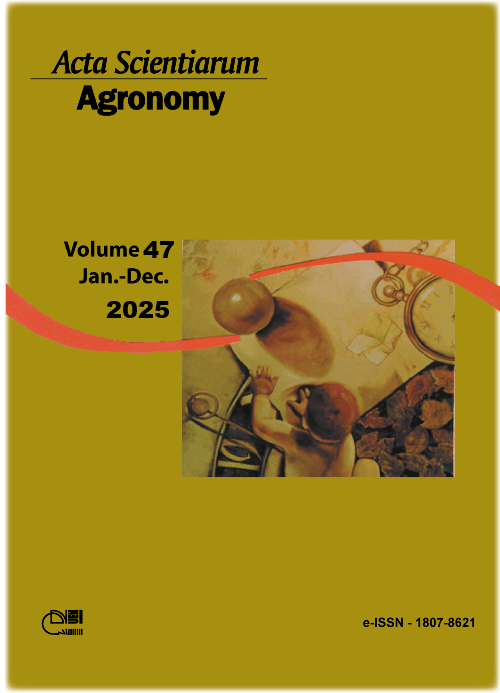Implications of plant survival in the quality of experiments to evaluate progenies of the genus Corymbia
Abstract
The evaluation of Corymbia maculata and C. torelliana progenies has received much attention in Brazil in the last decade. For the process to be efficient, experiments must be as precise as possible. Factors that affect accuracy include plant survival (PS) and assessment age. The objectives of this study were to determine whether there are differences in progeny PS among evaluation sites and ages, whether dominated plants affect precision estimates, and how potential damage caused by differences in PS can be mitigated. Data from the evaluation of half-sib progenies of C. maculata at three sites and C. torelliana at four sites were used. The experiments were implemented in an alpha-lattice design with 40 repetitions and a single-tree plot (STP). Diameter at breast height (DBH) and PS data were obtained at three and six years of age. All plants that presented DBH with a deviation below the mean (dominated plants) were not considered in the survival estimates. Although there was a difference in plant survival between progenies and experiments, none of the strategies used to mitigate damage due to differences in PS significantly changed the classification of progenies or the magnitude of the accuracy. There was a high association between the estimates obtained at three and six years of age, indicating that for species of the genus Corymbia, early selection is viable.
Downloads
References
Araujo, M. J., Dias, D. C., Scarpinati, E. A., & Paula, R. C. (2015). Number of replicates of plants per plot and of evaluations for eucalyptus clonal tests. Pesquisa Agropecuária Brasileira, 50(10), 923-931. https://doi.org/10.1590/S0100-204X2015001000008
Araujo, M. J., Lee, D. J., Tambarussi, E. V., Paula, R. C., & Silva, P. H. M. (2021). Initial productivity and genetic parameters of three Corymbia species in Brazil: designing a breeding strategy. Canadian Journal of Forest Research, 51(1), 25-30. https://doi.org/10.1139/cjfr-2019-0438
Bernardo, R. (2020). Reinventing quantitative genetics for plant breeding: something old, something new, something borrowed, something BLUE. Heredity, 125(6), 375-385. https://doi.org/10.1038/s41437-020-0312-1
Costa, R. B., Resende, M. D. V., Roa, R. A. R., Bungenstab, D. J., Martins, W. J., & Roel, A. R. (2009). Melhoramento genético de erva-mate nativa do estado de Mato Grosso do Sul. Bragantia, 68(3), 611-619.
Ferreira, G. C., Aguiar, A., Lima, B., Lima, J. L., Rezende, G. D. S. P., & Ramalho, M. A. P. (2020). Adjusting for the effect of missing or dominated plants in progeny and clonal trials of Eucalyptus. Canadian Journal of Forest Research, 50(4), 438-443. https://doi.org/10.1139/cjfr-2019-0398
Ferreira, M. (2015). A aventura dos eucaliptos. In M. V. Schumacher, & M. Vieira (Eds.), Silvicultura de eucalipto no Brasil (pp. 11-46). UFSM.
Ramalho, M. A. P., Ferreira, D. F., & Oliveira, A. C. (2012). Experimentação em genética e melhoramento de plantas. UFLA.
R Core Team. (2022). R: A language and environment for statistical computing. R Foundation for Statistical Computing.
Reis, C. A. F., Gonçalves, F. M. A., Ramalho, M. A. P., & Rosado, A. M. (2011). Selection of eucalyptus progenies by Z index through LSM and Blup. Pesquisa Agropecuária Brasileira, 46(5), 516-522. https://doi.org/10.1590/S0100-204X2011000500009
Reis, C. A. F., Assis, T. F., Santos, A. M., & Paludzyszyn Filho, E. (2014a). Corymbia maculata, estado da arte de pesquisas no Brasil. Embrapa Florestas.
Reis, C. A. F., Assis, T. F., Santos, A. M., & Paludzyszyn Filho, E. (2014b). Corymbia torelliana: estado da arte de pesquisas no Brasil. Embrapa Florestas.
Resende, M. D. V., & Alves, R. S. (2022). Statistical significance, selection accuracy, and experimental precision in plant breeding. Crop Breeding and Applied Biotechnology, 22(3), 1-19. https://doi.org/10.1590/1984-70332022v22n3a31
Resende, M. D. V. (2015). Genética quantitativa e de populações. Suprema.
Rezende, G. D. S. P., Bertolucci, F. L. G., & Ramalho, M. A. P. (1994). Eficiência da seleção precoce na recomendação de clones de eucalipto avaliados no norte do Espírito Santo e sul da Bahia. Cerne, 1(1), 45-50.
Rutkoski, J. E. (2019). A practical guide to genetic gain. Advances in Agronomy, 157, 217-249. https://doi.org/10.1016/bs.agron.2019.05.001
Santos, H. G., Gonçalves, F. M. A., Lima, J. L., Aguiar, A. M., Rezende, G. D. S. P., Lima, B. M., & Ramalho, M. A. P. (2021). Strategies for the analysis of single-tree plot experiments in Eucalyptus plantations. Journal of Forestry Research, 32(6), 2437-2445. https://doi.org/10.1007/s11676-021-01322-y
Silva, K. J., Menezes, C. B., Tardin, F. D., Souza, V. F., & Santos, C. V. (2014). Comparison of stand correction methods to estimate grain sorghum yield. Pesquisa Agropecuária Tropical, 44(2), 175-181. https://doi.org/10.1590/S1983-40632014000200005
Silva, P. H. M., Lee, D. J., Amancio, M. R., & Araujo, M. J. (2022). Initiation of breeding programs for three species of Corymbia: Introduction and provenances study. Crop Breeding and Applied Biotechnology, 22(1), 1-9. https://doi.org/10.1590/1984-70332022v22n1a01
Silva, P. H. M., Lee, D. J., Miranda, A. C., Marina, C. L., Moraes, M. L. T., & Paula, R. C. (2017). Survival and initial growth of eucalypts species across climatic conditions. Scientia Forestalis, 45(115), 563-571. https://doi.org/10.18671/scifor.v45n115.13
DECLARATION OF ORIGINALITY AND COPYRIGHTS
I Declare that current article is original and has not been submitted for publication, in part or in whole, to any other national or international journal.
The copyrights belong exclusively to the authors. Published content is licensed under Creative Commons Attribution 4.0 (CC BY 4.0) guidelines, which allows sharing (copy and distribution of the material in any medium or format) and adaptation (remix, transform, and build upon the material) for any purpose, even commercially, under the terms of attribution.




















































